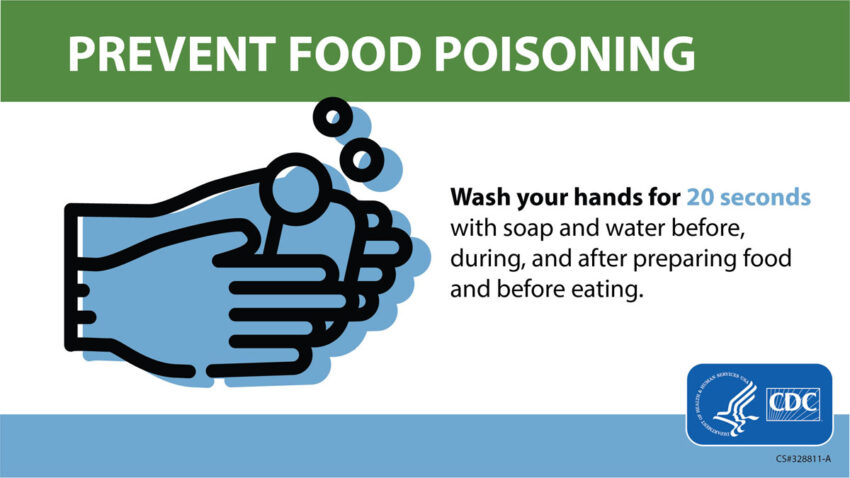
Share On Social!
When the holidays season is in full swing, families and friends gather to enjoy time together over warms meals and plenty of dessert.
But sometimes food spoils the party.
Every year, foodborne diseases sicken 1 in 6 Americans (48 million people), hospitalize 128,000 people, and kill 3,000 people, according to the CDC.
Let’s tackle how we can prepare food safely and keep the holidays healthy.
What Is Food Poisoning?
You can get sick with food poisoning after swallowing certain germs like salmonella.
Common symptoms include:
- Diarrhea
- Stomach pain or cramps
- Nausea
- Vomiting
- Fever
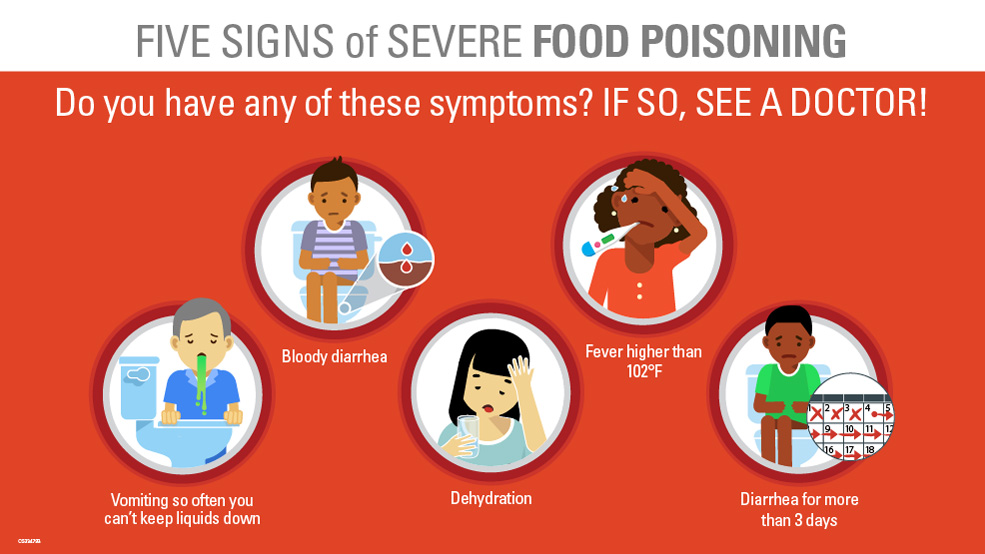 “Most people have mild illnesses [from food poisoning], but some infections spread by food are serious or even life-threatening. Some people may need to be hospitalized, and some illnesses lead to other health problems,” according to the CDC.
“Most people have mild illnesses [from food poisoning], but some infections spread by food are serious or even life-threatening. Some people may need to be hospitalized, and some illnesses lead to other health problems,” according to the CDC.
Serious health risks come from swallowing antimicrobial-resistant germs.
Individuals infected with antimicrobial-resistant germs might have more severe illness and fewer treatment options.
“Antimicrobial resistance happens when germs like bacteria and fungi develop the ability to defeat the drugs designed to kill them. That means the germs are not killed and continue to grow,” the CDC reports.
Fortunately, you can take action to handle, store, and prepare food safely.
The FDA recommends 4 specific tips:
1. Clean Up Before Preparing Food
Everything should be clean before preparing food. That starts with washing your hands.
“Wash hands with warm water and soap for 20 seconds before and after handling any food,” according to the FDA.
Also, sanitize surfaces before using them to prepare food.
This includes cutting boards, dishes, utensils, countertops, and other food-contact surfaces.
“Many different sanitizers can be used: an easy homemade version is to make a solution of one tablespoon of liquid chlorine bleach per gallon of water, or you can use a commercial sanitizer or sanitizing wipe,” according to the USDA.
Rinse fruits and vegetables thoroughly under cool running water. Use a produce brush to remove surface dirt.
Do not rinse raw meat and poultry before cooking. Doing so will increase the chances of bacteria to spread to areas around the sink and countertops.
2. Separate Foods
Cross-contamination is the transfer of harmful bacteria to food from other foods, cutting boards, and utensils if they are not handled properly.
You can avoid this by keeping foods separated – such as raw eggs, meat, poultry, seafood, and their juices – from foods that won’t be cooked.
“Consider using one cutting board only for foods that will be cooked (such as raw meat, poultry, and seafood) and another one for foods that will not be cooked (such as raw fruits and vegetables),” the FDA suggested.
Cooked meat or other food that is ready to eat should not be placed on unwashed plates that have held any raw eggs, meat, poultry, seafood, or their juices.
3. Cook Food Properly
Cook meat, poultry, and fish thoroughly and safely, reaching a high enough internal temperature to kill harmful bacteria.
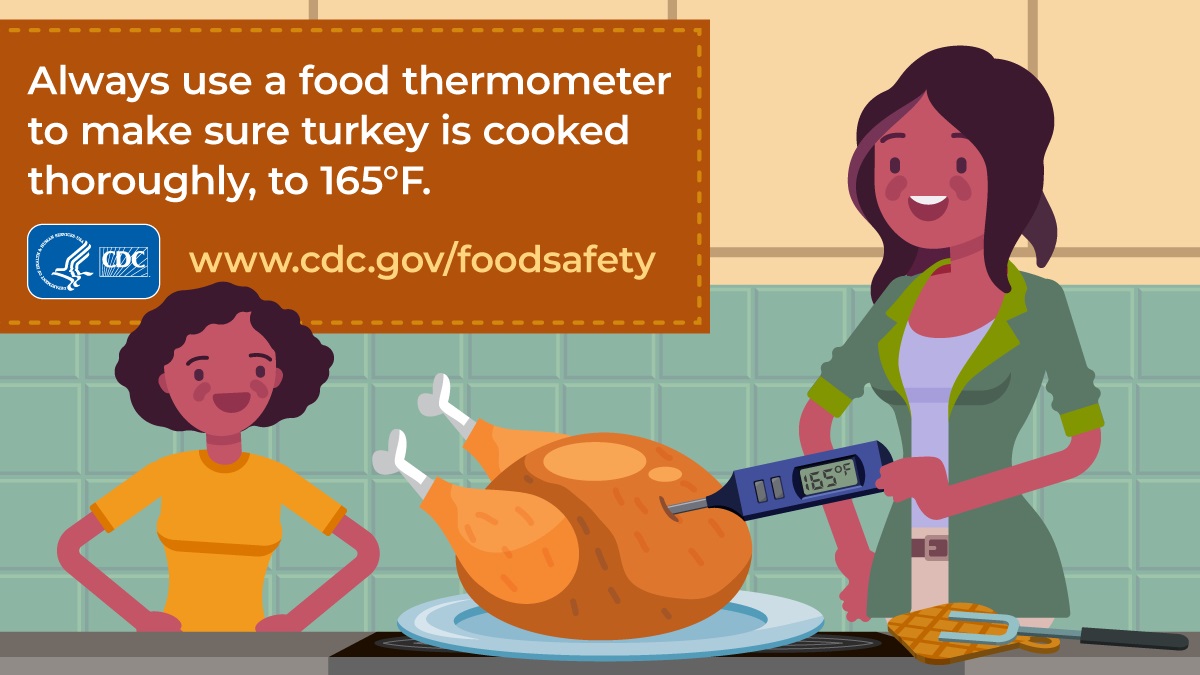
Use a food thermometer to ensure a safe internal temperature.
“To check a turkey for safety, insert a food thermometer into the innermost part of the thigh and wing and the thickest part of the breast,” according to the FDA. “The turkey is safe when the temperature reaches 165°F.”
The FDA also has a complete list of safe minimum internal temperatures for different foods.
Eating raw dough or batter can also be harmful.
“Do not taste or eat raw dough or batter that is meant to be baked or cooked. This includes dough or batter for cookies, cakes, pies, biscuits, pancakes, tortillas, pizza, or crafts,” according to the CDC.
4. Chill Correctly
Refrigerating and storing food safely and in a timely manner is also important. Harmful bacteria can grow rapidly at room temperature.
Keep food out of the “danger zone” – the range of temperatures where bacteria grow most rapidly (40°F and 140°F).
“After food is prepared, keep hot food hot and cold food cold. Refrigerate or freeze perishable food like meat, chicken, turkey, seafood, eggs, cut fruit, cooked rice, and leftovers within 2 hours,” according to the CDC.
Do not defrost food at room temperature. Rather, safely defrost it in the refrigerator, under cold running water, or in the microwave.
Cook food thawed in cold water or in the microwave immediately.
Use leftovers within 3-4 days.
Other Factors That Increase Food Poisoning
Several other factors can increase the risk of food poisoning.
Certain groups of people are more likely to get very sick from food poisoning.
The CDC recognizes that people age 65a and older have immune systems and organs that don’t recognize and get rid of harmful germs as well as they once did.
“Nearly half of people aged 65 and older who have a lab-confirmed foodborne illness from Salmonella, Campylobacter, Listeria or E. coli are hospitalized,” according to the CDC.
Similarly, younger children whose immune system is still developing are also at risk of becoming very sick. They can have trouble fighting germs and sickness.
“Children younger than 5 are three times more likely to be hospitalized if they get a Salmonella infection,” the CDC reports.
Pregnant women are also more likely than others to get sick. They are 10 times than their peers more likely to get a Listeria infection.
Those with weakened immune systems may also find it harder to fight food poisoning.
“Weakened immune systems may be due to diabetes, liver disease, kidney disease, alcoholism, HIV, autoimmune disorders such as lupus, or receiving chemotherapy or radiation therapy,” according to the CDC.
Many Latinos could be at risk due to disproportionately high rates of diabetes and cancer.
For more information about food safety, visit the FDA, USDA, and the CDC.
Analyze Your Community’s Health
It’s important to make sure you and your family are safe and healthy.
But what about the health of your community?
Look to Salud America’s Health Equity Report Card to see how healthy your county is.
Explore a variety of health-related topics including access to health care, transportation, and housing.
See how your county compares to others across the state and the nation.
Share your data results with local leaders and organizations to strive for change in your area!
By The Numbers
142
Percent
Expected rise in Latino cancer cases in coming years

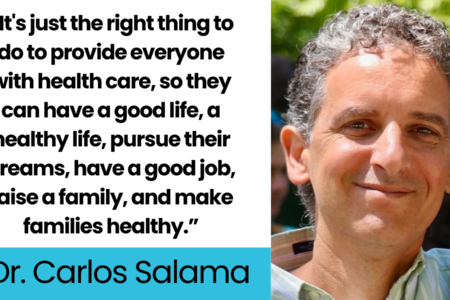

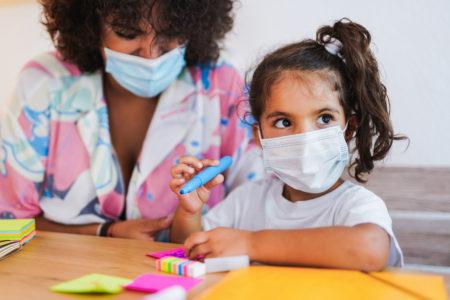
[…] The pandemic is another chapter in the bitter story of American racism and inequality. Black and Latinx people are being infected and are dying at much higher rates than white Americans. Many people of […]
[…] coronavirus has killed over 61,000 Latinos in America according to the CDC, accounting for over 18.2% of the total COVID deaths in the […]
[…] Whereas Hispanics make up 11% of D.C.’s inhabitants, they signify 19% of the COVID cases, and 14% of the deaths. Equally, 46% of D.C.’s residents are Black, they usually make up an alarming 75% […]
[…] and historical mistreatment. According to the U.S. Centers for Disease Control and Prevention, Latino and Black American communities are three times more likely to become infected with […]
[…] Covid pandemic has hit the Latino community particularly hard, and data from the nonprofit health equity advocacy group Salud America! shows Latinos lead in the 0-24 age […]
[…] the pandemic, Latinos took major blows, both in terms of COVID-19 cases and also from the economic recession under former President Donald Trump. Nearly half (49%) of […]
[…] the positive trend, the harm may have already been done. The pandemic has disproportionately impacted Latino communities. Reuters reported that election-related or political disinformation that […]
[…] pesar de la tendencia positiva, es posible que el daño ya esté hecho. La pandemia ha impactado desproporcionadamente Comunidades latinas. Reuters informó que la desinformación política o relacionada con las […]
[…] residentes blancos muestran una tasa mucho más baja con 10 muertes por cada 100,000 habitantes(8 9) . Los afroestadounidenses por su parte, denuncian subsistemas de salud que les segregan […]
[…] https://salud-america.org/coronavirus-case-rates-and-death-rates-for-latinos-in-the-united-states/ […]
[…] https://salud-america.org/coronavirus-case-rates-and-death-rates-for-latinos-in-the-united-states/ […]
[…] communities have the second-highest number of COVID-19 cases in the U.S. They’re also more likely to become hospitalized and die from the disease than other […]
[…] total, around 160,000 Latinos were killed by COVID-19. This accounts for 16% of the 1 million deaths in the country. The […]